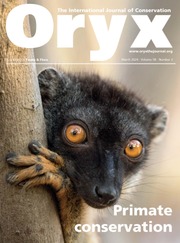During April–July 2025, news media reported five seizures of live striped rabbits at airports in India and one seizure in Thailand (outbound for India), involving 10 live animals and one reportedly dead. All striped rabbits confiscated in India had originated from Thailand, but their origin before entering Thailand, or whether they were bred legally or illegally after being trafficked into the country, remains unknown.
It is unclear how Indian authorities identified the confiscated animals as Sumatran striped rabbits Nesolagus netscheri rather than Annamite striped rabbits Nesolagus timminsi. Given their similar pelage and external morphology, accurate identification requires cranial measurements or genetic testing. Nesolagus netscheri occurs only in western and southern Sumatra (Indonesia), and N. timminsi occurs in the Annamite range of Laos and Vietnam. Both are rare, with N. timminsi categorized as Endangered and N. netscheri as Data Deficient on the IUCN Red List.
Illegal capture and sale of live Sumatran striped rabbits, particularly via social media, has been documented in Indonesia (Setiawan et al., 2020, Mammalia, 84, 250–252). For the Annamite striped rabbit, primary threats include snaring and sale as wild meat in Laos and Viet Nam (Rusman et al., 2023, Mammalia, 87, 615–618), with recent reports of live rabbits sold as pets in Viet Nam (Nguyen et al., 2023, Mammalia, 87, 374–378). These developments suggest an increasing supply of both species for the live animal trade, locally and for export.
Thailand’s vast live animal market regularly receives imported animals, legally and illegally, from around the world, and many are trafficked onward. The demand in India is new, apparently driven by a trend of keeping exotic animals as status symbols and tourist attractions. Indian Customs frequently intercepts live animals trafficked from Southeast Asia, but many are probably undetected, as seizures often rely on tip-offs. Once in India, enforcement becomes problematic, as neither striped rabbit species is protected under Indian wildlife law. Thailand similarly does not protect these species. Both countries, like many others, do not protect non-native species unless listed under CITES.
As conservationists working on these rare and threatened species, we are alarmed by this emerging threat and urge relevant governments to curb poaching, trafficking and demand. A critical step is for Indonesia and Viet Nam to list their respective striped rabbit species under CITES Appendix III. They can do this unilaterally and swiftly, strengthening interdictions, closing legal loopholes in Thailand and India, regulating possession, and enabling prosecution of future buyers.
India routinely returns confiscated live animals to the port of origin, in this case, Bangkok. Indonesia and Viet Nam should engage Thai authorities to care for seized animals, identify species and repatriate them to their native countries. Conservation organizations can support this process with technical and financial assistance. Repatriated rabbits should be rehabilitated and used in captive breeding to establish insurance populations. Viet Nam has a new facility in Bach Ma National Park for N. timminsi, and Indonesia holds a small number of N. netscheri in a conservation breeding centre.

